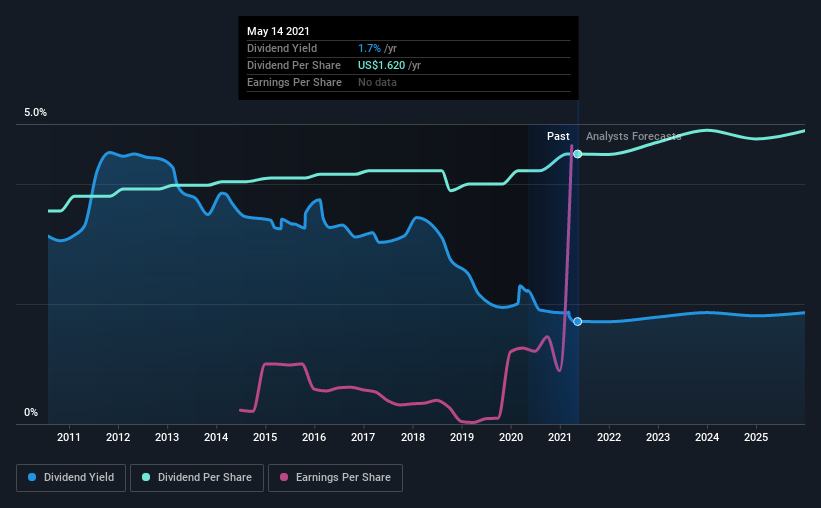Thomson Reuters Corporation (TSE:TRI) Looks Interesting, And It's About To Pay A Dividend
Thomson Reuters Corporation (TSE:TRI) is about to trade ex-dividend in the next three days. The ex-dividend date is usually set to be one business day before the record date which is the cut-off date on which you must be present on the company's books as a shareholder in order to receive the dividend. It is important to be aware of the ex-dividend date because any trade on the stock needs to have been settled on or before the record date. Meaning, you will need to purchase Thomson Reuters' shares before the 19th of May to receive the dividend, which will be paid on the 15th of June.
The company's next dividend payment will be US$0.41 per share, and in the last 12 months, the company paid a total of US$1.62 per share. Last year's total dividend payments show that Thomson Reuters has a trailing yield of 1.7% on the current share price of CA$114.84. Dividends are a major contributor to investment returns for long term holders, but only if the dividend continues to be paid. That's why we should always check whether the dividend payments appear sustainable, and if the company is growing.
View our latest analysis for Thomson Reuters
Dividends are usually paid out of company profits, so if a company pays out more than it earned then its dividend is usually at greater risk of being cut. Thomson Reuters is paying out just 13% of its profit after tax, which is comfortably low and leaves plenty of breathing room in the case of adverse events. Yet cash flows are even more important than profits for assessing a dividend, so we need to see if the company generated enough cash to pay its distribution. Over the last year it paid out 51% of its free cash flow as dividends, within the usual range for most companies.
It's positive to see that Thomson Reuters's dividend is covered by both profits and cash flow, since this is generally a sign that the dividend is sustainable, and a lower payout ratio usually suggests a greater margin of safety before the dividend gets cut.
Click here to see the company's payout ratio, plus analyst estimates of its future dividends.
Have Earnings And Dividends Been Growing?
Companies with consistently growing earnings per share generally make the best dividend stocks, as they usually find it easier to grow dividends per share. Investors love dividends, so if earnings fall and the dividend is reduced, expect a stock to be sold off heavily at the same time. It's encouraging to see Thomson Reuters has grown its earnings rapidly, up 52% a year for the past five years.
The main way most investors will assess a company's dividend prospects is by checking the historical rate of dividend growth. In the last 10 years, Thomson Reuters has lifted its dividend by approximately 2.4% a year on average. It's good to see both earnings and the dividend have improved - although the former has been rising much quicker than the latter, possibly due to the company reinvesting more of its profits in growth.
Final Takeaway
From a dividend perspective, should investors buy or avoid Thomson Reuters? From a dividend perspective, we're encouraged to see that earnings per share have been growing, the company is paying out less than half of its earnings, and a bit over half its free cash flow. Thomson Reuters looks solid on this analysis overall, and we'd definitely consider investigating it more closely.
In light of that, while Thomson Reuters has an appealing dividend, it's worth knowing the risks involved with this stock. For instance, we've identified 4 warning signs for Thomson Reuters (2 are concerning) you should be aware of.
If you're in the market for dividend stocks, we recommend checking our list of top dividend stocks with a greater than 2% yield and an upcoming dividend.
This article by Simply Wall St is general in nature. It does not constitute a recommendation to buy or sell any stock, and does not take account of your objectives, or your financial situation. We aim to bring you long-term focused analysis driven by fundamental data. Note that our analysis may not factor in the latest price-sensitive company announcements or qualitative material. Simply Wall St has no position in any stocks mentioned.
Have feedback on this article? Concerned about the content? Get in touch with us directly. Alternatively, email editorial-team (at) simplywallst.com.


